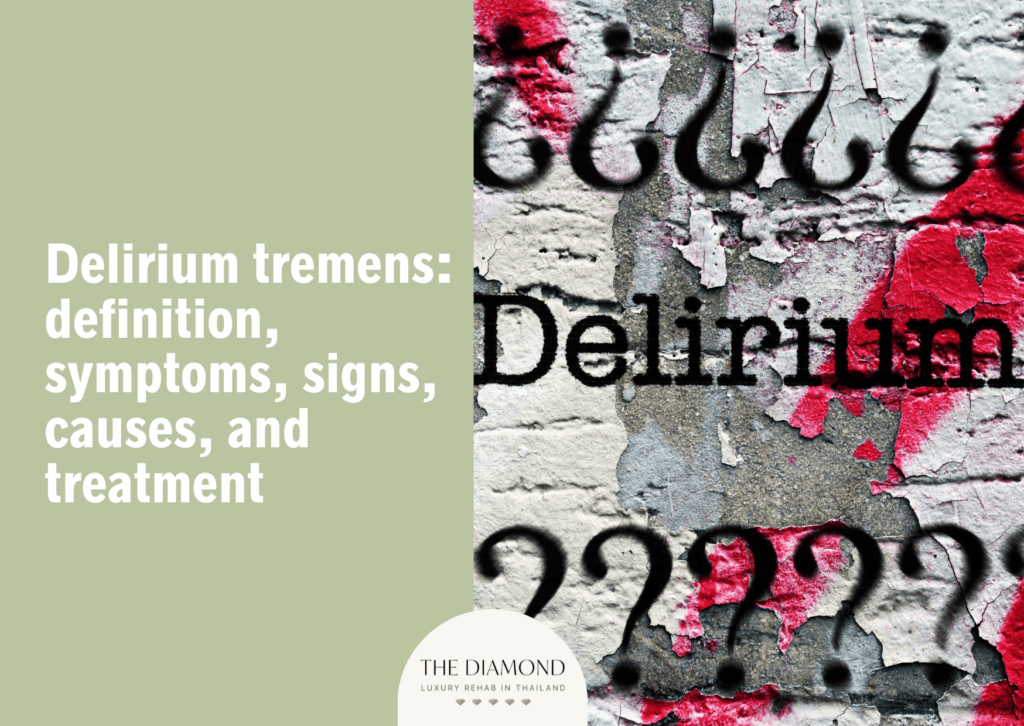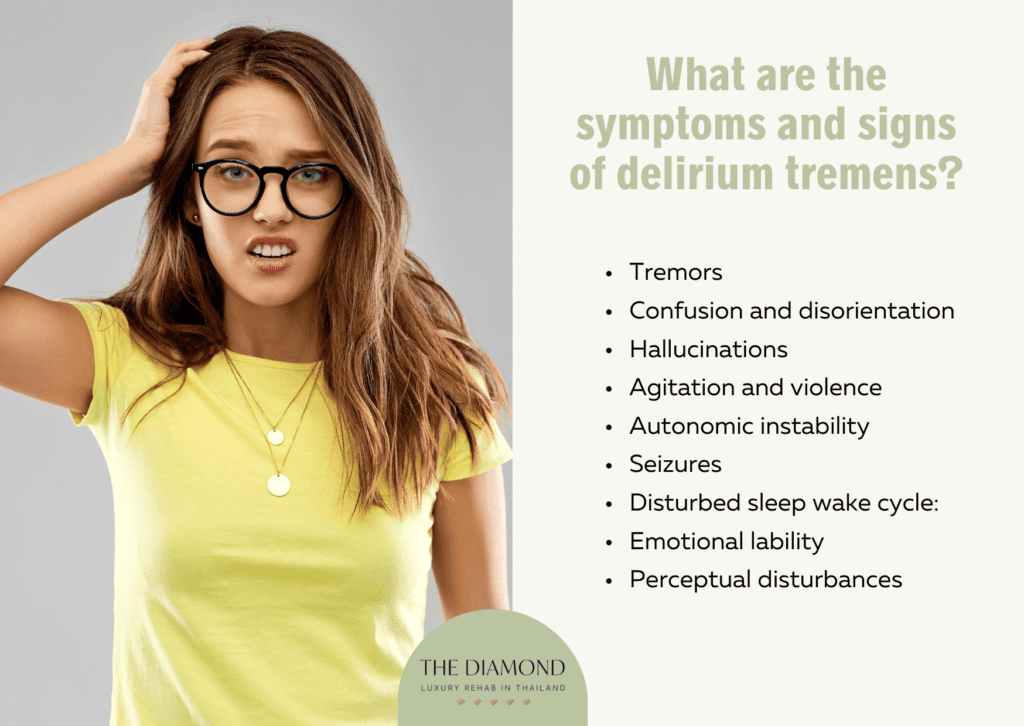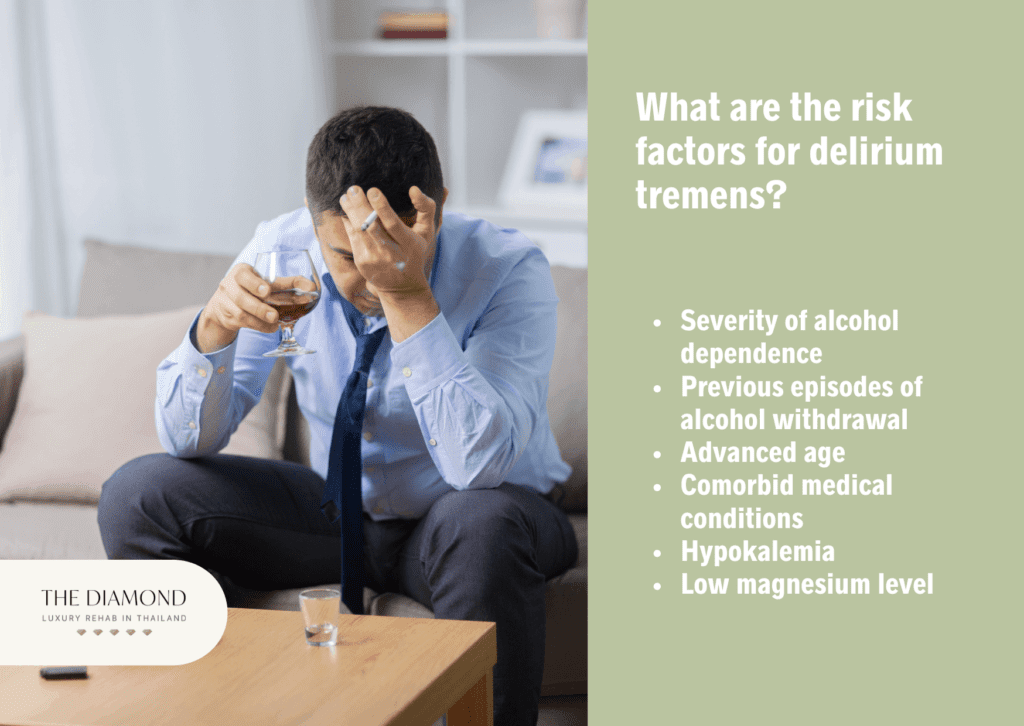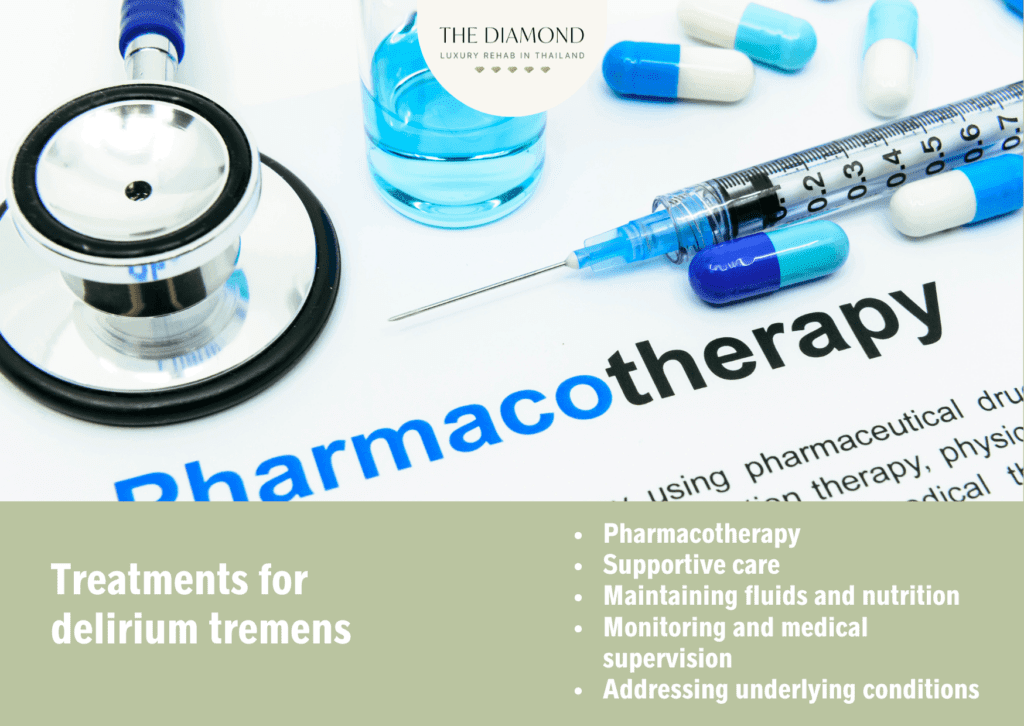Delirium tremens: definition, symptoms, signs, causes, and treatment
Table of content
- What is delirium tremens?
- What are the symptoms and signs of delirium tremens?
- What are the causes of delirium tremens?
- When does delirium tremens occur?
- What are the risk factors for delirium tremens?
- How is delirium tremens diagnosed?
- What are the treatments for delirium tremens?
- How can delirium tremens be prevented?
- Can delirium tremens be fatal?
- What is the difference between seizure and delirium tremens?

Delirium tremens is a severe form of alcohol withdrawal that involves sudden and severe mental or nervous system changes. It usually occurs in people who have been drinking heavily for a long time and suddenly stop or significantly reduce their alcohol intake. Despite its relatively low frequency compared to overall alcohol withdrawal cases, delirium tremens is considered a medical emergency associated with severity of its symptoms.
Symptoms and signs of delirium tremens include tremors, confusion and disorientation, hallucinations, agitation and violence, autonomic instability, seizures, disturbed sleep wake cycle, emotional lability, and perceptual disturbances.
Risk factors of delirium tremens encompass severity of alcohol dependence, previous episodes of alcohol withdrawal, advanced age, comorbid medical conditions, hypokalemia, and low magnesium level.
Treatment of delirium tremens include pharmacotherapy, supportive care, maintaining fluids and nutrition, monitoring and medical supervision, and addressing underlying conditions.
What is delirium tremens?
Delirium tremens is a life-threatening alcohol withdrawal syndrome, first recognized in 1813 as a disorder attributed to excessive alcohol use. This rare but severe form of alcohol withdrawal is associated with intense symptoms, including severe anxiety, disorientation, tremors, paranoia, hallucinations, profuse perspiration, increased body temperature, palpitations, and elevated blood pressure. Delirium tremens is considered a medical emergency.
The name “Delirium Tremens” has a curious history. According to the research article “First Description of Delirium Tremens was Made by Diego de Torres Villarroel in 1737” authored by Ángel Royuela Rico published in the journal Actas españolas de psiquiatría in 2024, Dr. Sutton in Great Britain coined the term in 1813 when he described the shakes and hallucinations plaguing people who heavily consumed alcohol.
However, there’s a wrinkle in the timeline. Dr. Diego de Torres Villarroel, from Spain, published a case report compilation between 1736 and 1737 titled “The Disposed of the World and of Glory.” In this work, Villarroel detailed a case involving a young man who exhibited symptoms such as tremors, agitation, hallucinations that align perfectly with modern clinical criteria for delirium tremens. He associated these symptoms with excessive alcohol consumption. Therefore, this condition was recognized much earlier than previously thought, despite the formal term “delirium tremens” not being coined until later in the 19th century by Thomas Sutton. Villarroel’s observations predate Sutton’s by several decades, suggesting that the link between heavy drinking and these severe symptoms was known, though not fully understood or formalized, until the 19th century.
What is another name for delirium tremens?
Another name for delirium tremens is alcohol withdrawal delirium (AWD). Introduced in 1813, the term “delirium tremens” describes symptoms that have been recognized since the 1700s. The word “delirium,” derived from Latin meaning going off the furrow, signifies disordered thinking. The condition is referred to as the shaking frenzy or Saunders-Sutton syndrome and is commonly known by nicknames such as “the DTs” or “seeing pink elephants.”
What happens to the brain during delirium tremens?
During delirium tremens (DT), the brain undergoes neurophysiological changes due to setting in of alcohol withdrawal. This withdrawal triggers a cascade of disturbances within the central nervous system, leading to a state of hyperexcitability.
According to research article “Identification and Management of Alcohol Withdrawal Syndrome” by Antonio Mirijello et al. published in the journal Drugs in 2016, abrupt cessation of alcohol consumption disrupts the delicate equilibrium between excitatory and inhibitory neurotransmitters, particularly glutamate and gamma-aminobutyric acid (GABA). This disruption leads to a state of hyperexcitability in the central nervous system. The up-regulation of dopaminergic and noradrenergic pathways contribute to hallucinations and autonomic hyperactivity observed during DT. Elevated glutamate activity, combined with decreased GABAergic inhibition, drives the hallmark symptoms of DTs, such as severe tremors, agitation, autonomic instability, and hallucinations.
How common is delirium tremens?
Delirium tremens account for 3% to 5% of severe alcohol withdrawal cases, characterized by marked confusion, autonomic hyperactivity, and cardiovascular collapse, as evidenced in the research article “Delirium Tremens” by Abdul Rahman and Manju Paul, published in the book StatPearls, last updated in 2023.
Another study “Prevalence and Characteristics of Patients With Delirium Tremens: A Cross Sectional Study” by Sulochana Joshi et al., published in the Journal of Psychiatrists’ Association of Nepal in 2021, found a prevalence of 69.52%, higher than previous studies demonstrating 3-33%.
What are the symptoms and signs of delirium tremens?

The symptoms and signs of delirium tremens are listed below.
Tremors: Tremors in delirium tremens typically manifest as generalized, involving the entire body. These tremors are a notable indication of the severe physiological effects of alcohol withdrawal on the central nervous system, as evidenced in the article “Delirium Tremens: Assessment and Management” by Sandeep Grover and Abhishek Ghosh published in the Journal of Clinical and Experimental Hepatology in 2018.
Confusion and disorientation: Confusion and disorientation are hallmark symptoms of delirium tremens, characterized by profound cognitive impairment and disorientation. According to a recent study by Alan D. Kaye et al. titled “Delirium Tremens: A Review of Clinical Studies,” published in the journal Cureus in 2024, delirium tremens represents a severe form of alcohol withdrawal syndrome (AWS) prominently marked by these symptoms.
Hallucinations: Hallucinations are a prominent feature of delirium tremens, where individuals experience perceptions of objects or people that are not actually present. These hallucinations are of several forms, including auditory, visual, and tactile. These hallucinations are vivid and distressing, contributing significantly to the agitation observed during delirium tremens. The case study “Twenty-Eight-Day-Long Delirium Tremens” by Paritosh Kafle et al. published in the Journal of Investigative Medicine High Impact Case Reports in 2019, illustrates a rare instance of prolonged and refractory delirium tremens. Typically, delirium tremens emerges shortly after alcohol cessation and resolves within several days. However, this particular case required escalating doses of medications for management. Despite intensive treatment efforts, the patient continued to experience persistent tactile hallucinations characteristic of delirium tremens.
Agitation and violence: Delirium tremens are often present with heightened agitation and violence, which range from pacing to more aggressive behaviors. A study titled “Risk factors for inducing violence in patients with delirium” by Masako Tachibana et al. published in the journal Brain and Behavior in 2021, found that inpatients with delirium are more likely to be aggressive than other patients. Because delirium symptoms change quickly, outbursts are unpredictable. As a result, physical restraints or sedative medications are often employed to manage and control the patient’s behavior.
Autonomic instability: Delirium tremens is associated with autonomic nervous system dysfunction as evidenced in the research article “Delirium Tremens: Assessment and Management” by Sandeep Grover and Abhishek Ghosh published in the Journal of Clinical and Experimental Hepatology in 2018. Autonomic symptoms consist of rapid heartbeat (tachycardia), fever, sweating, and hypertension.
Seizures: Delirium tremens are often marked by generalized tonic-clonic (grand mal) seizures. According to a research titled “Convulsive Seizures in Delirium Tremens” by Milton Rosenbaum, published in the journal Archives of Neurology & Psychiatry in 1941, patients with delirium tremens experience seizures or convulsions, often referred to as “whisky fits.” These frequently begin before withdrawal, developing into delirium tremens. Seizures are serious or even fatal if they progress to status epilepticus, which is a seizure lasting for 30 minutes.
Disturbed sleep wake cycle: Disruptions in the sleep-wake cycle are often observed as a notable sign. This cycle refers to the natural pattern of alternating between periods of wakefulness and sleep that typically follows a roughly 24-hour rhythm.
Emotional lability: Emotional lability is a significant sign of delirium tremens, characterized by rapid and unpredictable shifts in emotional expression and mood. In delirium tremens, individuals experience sudden mood swings, intense emotional reactions disproportionate to the situation, and difficulty regulating emotions. This emotional instability manifests as outbursts of tears, laughter, or irritability, often without clear triggers.
Perceptual disturbances: Perceptual disturbances are key symptoms of delirium tremens marked by significant alterations in sensory perception. Delirium tremens often include vivid visual, auditory, and tactile hallucinations where individuals perceive unreal stimuli. These experiences intensify anxiety and confusion and distort their sense of time and space.
What are the causes of delirium tremens?
The causes of delirium tremens are listed below.
History of alcohol abuse: Individuals who develop delirium tremens often have a prolonged history of alcohol addiction, sometimes spanning several years or even decades. This chronicity contributes to greater physiological dependence and tolerance to alcohol.
Sudden alcohol cessation and withdrawal: Acute alcohol withdrawal is primarily triggered by the sudden cessation of alcohol intake following a period of chronic use. This abrupt change disturbs the body’s established equilibrium, often resulting in severe withdrawal symptoms.
Neurophysiological factors: Sudden alcohol cessation disrupts the balance in neurotransmitters like glutamate, leading to hyperexcitability in the brain. If untreated, this imbalance progresses to delirium tremens, as highlighted in the article titled “History of Delirium Tremens in AUD Patients in Treatment: Relationship to AUD Severity and Other Factors” by Jørgen G. Bramness et al. published in the journal Substance Abuse and Rehabilitation in 2022.
Traumatic brain injury: Head injuries trigger delirium, confusion, and memory problems. According to the study titled“Occurrence, Predictors, and Prognosis of Alcohol Withdrawal Syndrome and Delirium Tremens Following Traumatic Injury” by Kristin Salottolo et al. published in the journal Critical Care Medicine in 2017, patients with trauma who experience alcohol withdrawal syndrome (AWS) have a high incidence of delirium tremens, linked to significant mortality.
When does delirium tremens occur?
Delirium tremens (DT) occurs as soon as 48-72 hours after sudden cessation of alcohol in individuals with chronic use, as outlined in the research article “Delirium Tremens: Assessment and Management” by Sandeep Grover and Abhishek Ghosh published in the Journal of Clinical and Experimental Hepatology in 2018. Prompt identification and treatment are essential for enhancing outcomes and minimizing the potential for complications.
How long does delirium tremens last?
Delirium tremens typically lasts for about 3 to 4 days, although in some cases, it extends up to 8 days as evidenced in the research article “Delirium Tremens: Assessment and Management” by Sandeep Grover and Abhishek Ghosh published in the Journal of Clinical and Experimental Hepatology in 2018. It commonly concludes with a prolonged period of sleep, marking the end of the acute phase of alcohol withdrawal. As previously mentioned, delirium tremens typically develop between 48 to 72 hours after the last alcoholic drink. Therefore, it is crucial to inquire about the time elapsed since the individual’s last drink when assessing the risk and potential onset of delirium tremens.
What are the risk factors for delirium tremens?

The risk factors for delirium tremens are listed below.
- Severity of alcohol dependence: The research article “Risk factors for the development of delirium in alcohol dependence syndrome: Clinical and neurobiological implications” by Sukanto Sarkar et al. published in the Indian Journal of Psychiatry in 2017, identifies heavy alcohol consumption as a significant risk factor for prolonged delirium following cessation.
- Previous episodes of alcohol withdrawal: Individuals who have experienced previous episodes of alcohol withdrawal, particularly those complicated by seizures or delirium tremens, face an elevated risk of delirium tremens during subsequent withdrawal episodes. This association was highlighted in a study titled “Alcohol withdrawal syndrome: mechanisms, manifestations, and management” by S. Jesse et al., published in the journal Acta Neurologica Scandinavica in 2016. The research underscored that a history of alcohol withdrawal seizures serves as a significant predictor for the development of delirium tremens in subsequent withdrawal episodes.
- Advanced age: Advanced age correlates with a heightened risk of delirium tremens, possibly due to physiological changes impacting alcohol metabolism and amplifying susceptibility to withdrawal complications, as supported by findings in the research article “Delirium Tremens in the Older Adult” authored by Malissa A. Mulkey and DaiWai M. Olson, published in The Journal of Neuroscience Nursing in 2020.
- Comorbid medical conditions: Comorbid medical conditions such as liver disease, electrolyte abnormalities, heart disease, infections, and central nervous system (CNS) pathology worsen the severity of alcohol withdrawal and elevate the risk of delirium tremens.
- Hypokalemia: A 1978 study titled “Does Hypokalemia Precede Delirium Tremens?” authored by Wadstein and Skude published in the journal The Lancet, suggests a link between low potassium (hypokalemia) and delirium tremens in alcoholics withdrawing from alcohol. Those who developed delirium tremens experienced a drop in potassium levels, which returned to normal after recovery. This suggests that potassium levels are a marker for predicting or understanding delirium tremens in alcoholics.
- Low magnesium level: Low magnesium levels are found to be predictors of delirium tremens as evidenced in the research article “Delirium Tremens: Assessment and Management” by Sandeep Grover and Abhishek Ghosh published in the Journal of Clinical and Experimental Hepatology in 2018.
Who is at risk of developing delirium tremens?
Individuals at risk for delirium tremens (DT) include those with a history of chronic and heavy alcohol consumption, especially if they have previously experienced alcohol withdrawal symptoms such as seizures or DT. If someone has been drinking heavily for 10 years or more, it is important not to stop abruptly.
Drinking large amounts of alcohol daily for several months, especially more than four pints of wine, seven to eight pints of beer, or half a liter of spirits, significantly raises the chance of developing DT.
How is delirium tremens diagnosed?
Delirium tremens is diagnosed by clinical evaluation, typically involving a detailed neurological and medical examination. Clinicians assess the patient’s history, such as alcohol consumption patterns, and look for specific symptoms during the examination, including severe agitation, visual hallucinations, disorientation, and physical signs like elevated heart rate, high blood pressure, and fever. Diagnostic criteria, such as those outlined in the Diagnostic and Statistical Manual of Mental Disorders, Fifth Edition (DSM-5), are utilized to confirm the diagnosis.
According to the guidelines titled “The ASAM Clinical Practice Guideline on Alcohol Withdrawal Management” published by the American Society of Addiction Medicine in 2020, tools like the Clinical Institute Withdrawal Assessment for Alcohol, Revised (CIWA-Ar), are typically employed to assess the severity of withdrawal symptoms. A score greater than 19 on the CIWA-Ar indicates a high likelihood of delirium. This scoring system considers signs like difficulty understanding instructions, confusion, and the presence of new hallucinations.
It’s important to differentiate delirium tremens from other alcohol-related conditions like alcohol hallucinosis or alcohol-induced psychotic disorder through careful clinical assessment and diagnostic criteria application.
What are the treatments for delirium tremens?

The treatments for delirium tremens are listed below.
- Pharmacotherapy: The research article “Delirium Tremens” by Abdul Rahman and Manju Paul, published in the book StatPearls, last updated in 2023, benzodiazepines are the primary treatment for delirium tremens, a severe form of alcohol withdrawal. These medications, such as lorazepam or diazepam, are given intravenously to stabilize the patient’s withdrawal symptoms. The dosage is adjusted based on the severity of symptoms, either through regular dosing or as needed. In severe cases unresponsive to benzodiazepines, barbiturates like phenobarbital are used in combination to control symptoms. Additional medications include anticonvulsants to prevent or stop seizures, and antipsychotic medications to prevent hallucinations.
- Supportive care: Providing a safe and calm environment is essential. Patients with delirium tremens are often agitated and confused, so ensuring their safety from self-harm or accidents is paramount. Monitoring vital signs (e.g., heart rate, blood pressure, temperature) and managing any complications like dehydration or electrolyte imbalances are critical aspects of supportive care.
- Maintaining fluids and nutrition: People with delirium tremens often experience dehydration and nutrient deficiencies. To address this, healthcare providers administer fluids and essential vitamins and minerals directly into the bloodstream through an IV. Specialized IV fluids, such as the “banana bag,” are commonly used. This fluid contains vital nutrients like vitamin B1, vitamin B9, and electrolytes to help restore balance and support recovery.
- Monitoring and medical supervision: Continuous monitoring of vital signs, mental status, and response to treatment is significant. This often requires intensive care unit (ICU) admission for close observation and management of complications.
- Addressing underlying conditions: If there are underlying medical conditions contributing to delirium tremens such as liver disease, they need to be managed appropriately.
Can a patient with delirium tremens recover without treatment?
No, a patient with delirium tremens cannot recover without treatment. Delirium tremens necessitates immediate medical attention due to its potential for fatality if untreated. Death often results from complications such as inadequate regulation of body temperature, abnormal heart rhythms, heightened seizure activity due to alcohol withdrawal, or exacerbation of pre-existing medical conditions.
Delirium tremens is considered a medical emergency characterized by profound neurological disturbances resulting from alcohol withdrawal. Without appropriate treatment, which often involves medications such as benzodiazepines to manage withdrawal symptoms and prevent complications like seizures and cardiovascular instability, the condition worsens, leading to serious outcomes including death.
According to the manual titled“Detoxification and Substance Abuse Treatment: A Treatment Improvement Protocol” published by the Substance Abuse and Mental Health Services Administration (SAMHSA), U.S. Department of Health and Human Services, last updated in 2015, advises that patients at risk of seizures or delirium tremens need to be sent to a medical facility for immediate care and potential medication. After managing the acute symptoms, they should be transferred to a social detoxification setting for ongoing monitoring and observation.
How can delirium tremens be prevented?
Delirium tremens can be prevented by abstaining from alcohol altogether. However, if choosing to drink, it’s crucial to stay within the recommended limits. According to the article “Dietary Guidelines for Americans, 2020–2025” by Linda G. Snetselaar et al. published in the journal Nutrition Today in 2021, the US Departments of Agriculture (USDA) and of Health and Human Services (HHS), advises against starting to drink alcohol or continuing to drink alcohol solely for health reasons for those who do not currently drink. For adults who do consume alcohol, the Committee recommends limiting intake to no more than 1 drink per day for both women and men. This recommendation underscores that reducing alcohol consumption generally promotes better overall health.
For individuals who consume large amounts of alcohol and are at risk for withdrawal symptoms, particularly those with risk factors for severe withdrawal including seizures and delirium tremens, seeking professional help is critical before quitting or significantly reducing alcohol intake. Early intervention from a doctor or treatment center significantly decreases the risk of withdrawal symptoms escalating into delirium tremens.
Can delirium tremens be fatal?
Yes, delirium tremens can be fatal if left untreated. In the study“Mortality and alcohol-related morbidity in patients with delirium tremens, alcohol withdrawal state or alcohol dependence in Norway: A register-based prospective cohort study” by Jørgen G. Bramness et al. published in the journal Addiction in 2023, it was found that delirium tremens patients had a higher annual mortality rate of 8.0% compared to alcohol withdrawal syndrome (AWS) patients, which was 5.0%, and alcohol dependence (AD) patients, which was 3.6%, respectively.
Delirium tremens need to be managed as a medical emergency to prevent the progression from minor to severe symptoms. This involves providing prompt, adequate, and protocol-driven treatment of alcohol withdrawal. Nevertheless, ongoing treatment for alcohol dependence is essential for comprehensive delirium tremens management to decrease the risk of seizures, injury, and mortality.
What is the mortality rate associated with delirium tremens?
The mortality rate associated with delirium tremens is up to 37% without relevant treatment, according to the article “Delirium Tremens” by Abdul Rahman and Manju Paul, published in the book StatPearls, last updated in 2023. Even with effective treatment, mortality still ranges from 5% to 15%. The article emphasizes the critical role of prompt and aggressive resuscitation measures, along with addressing any coexisting illnesses, to reduce fatalities. Delays in diagnosis or inadequate treatment are consistently linked to a significant increase in morbidity and mortality.
Another study titled“Twenty-Eight-Day-Long Delirium Tremens” authored by Paritosh Kafle et al., and published by the Journal of Investigative Medicine High Impact Case Reports in 2019, estimates that 2% to 5% of hospitalized alcoholic patients suffer from delirium tremens, which has a mortality rate of about 1% to 15%.
What makes delirium tremens potentially deadly?
Delirium tremens is potentially deadly due to severe autonomic instability, profound dehydration and electrolyte imbalances, cardiorespiratory problems, infections, seizures, and extreme mental status changes. These complications require immediate medical intervention to prevent life-threatening outcomes.
Delirium tremens is potentially deadly due to several severe complications that arise during its course. Severe autonomic instability leads to extreme fluctuations in heart rate and blood pressure, risking cardiovascular collapse. Profound dehydration and electrolyte imbalances occur due to excessive sweating and vomiting, which result in life-threatening cardiac arrhythmias. Respiratory problems develop from respiratory distress or aspiration, leading to severe respiratory failure.
Additionally, infections set in, exacerbating the individual’s already compromised health. Seizures, a common feature of delirium tremens, cause significant injury or further destabilize vital functions. Extreme mental status changes, including severe agitation and confusion, heighten the risk of injury and complicate medical management. These complications necessitate immediate medical intervention to prevent fatal outcomes.
What is the difference between seizure and delirium tremens?

The difference between seizure and delirium tremens lies in their causes, clinical presentations or symptoms, and timing within the context of alcohol withdrawal. Seizures and delirium tremens (DTs) are both life-threatening. While seizures are more prevalent and widely recognized, DTs, though less common, have a higher risk of fatality compared to seizures.
A seizure is a sudden, uncontrolled burst of electrical activity in the brain. It causes a wide range of changes in behavior, movements, feelings, and levels of consciousness. Seizures during alcohol withdrawal typically manifest as sudden jerking movements (tonic-clonic seizures) or other types of abnormal behaviors due to disrupted brain activity.
In contrast, delirium tremens is a severe and potentially life-threatening alcohol withdrawal syndrome. It typically occurs as soon as 48-72 hours after abrupt cessation of alcohol intake in individuals with severe alcohol dependence. Delirium tremens is characterized by profound confusion, disorientation, vivid hallucinations (often visual), severe tremors, autonomic instability (such as rapid heart rate and sweating), and seizures. Seizures are most common within the first 12 to 48 hours and are more likely in individuals with a history of complications from alcohol withdrawal. It requires immediate medical attention and intensive care to manage symptoms and prevent complications.
Seizures arise from a wide array of causes including alcohol withdrawal, brain infections, congenital brain issues, choking incidents, substance use or withdrawal, electrolyte imbalances, electric shock, epilepsy, high blood pressure, fever, head trauma, organ failure, low blood glucose levels, strokes, brain tumors, or vascular brain abnormalities. Each condition disrupts normal brain function uniquely, resulting in seizures of varying severity.
In contrast, delirium tremens primarily stem from severe alcohol withdrawal. Delirium tremens occur when individuals abruptly stop or reduce heavy alcohol consumption, especially in cases of chronic alcohol dependence. Factors contributing to delirium tremens include advanced age, previous delirium tremens episodes, underlying medical conditions like liver disease or electrolyte imbalances, and sudden changes in alcohol intake patterns. Unlike seizures, which have diverse causes, delirium tremens are closely tied to the physiological and neurochemical adaptations associated with chronic alcohol use and withdrawal.
Seizures are primarily managed with antiepileptic drugs to prevent seizure recurrence and stabilize the individual’s condition. Delirium tremens represent a medical emergency due to its potential for life-threatening complications, requiring intensive medical management with benzodiazepines to control agitation, prevent seizures, and stabilize the individual’s condition. Supportive care is essential to address associated medical issues and ensure physiological stability.
In summary, while both seizures and delirium tremens are complications of alcohol withdrawal, they differ significantly in their clinical presentation, timing of onset, severity, and management strategies. Understanding these distinctions is essential for healthcare providers to promptly recognize and effectively manage these potentially serious conditions in individuals undergoing alcohol withdrawal.


